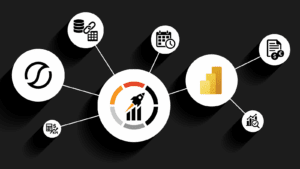
You’ve invested millions in implementing JD Edwards. Your team can process invoices, manage purchase orders, and track inventory like clockwork. But when your CFO asks for last quarter’s profit margins by business unit, or a project manager needs real-time cost analysis, everything grinds to a halt. Sound familiar? You’re not alone. JD Edwards excels at what it was designed for—capturing transactions with precision. But when it comes to getting meaningful intelligence back out, the system often becomes the biggest roadblock. The problem isn’t your team or your budget. The issue is fundamental: JD Edwards reporting was never built for modern, self-service analytics. Let’s explore why this happens, what it’s costing your business, and most importantly, how to build a scalable, future-ready analytics solution on top of your JDE investment without ripping and replacing your ERP.
The Real Problem: When Great ERP Meets Terrible Reporting
Most JD Edwards implementations follow a predictable pattern. The system works beautifully for daily operations—your warehouse staff can process shipments, accounting can handle invoices, and procurement can manage purchase orders. Everything runs smoothly until someone asks a seemingly simple question: “What were our gross margins by product line last month?” That’s when you discover the harsh reality. Your business analyst disappears for three hours, exports data to multiple spreadsheets, and returns with a report that nobody quite trusts because the numbers don’t match what finance reported last week. This isn’t a training problem or a user error. It’s a structural limitation that stems from how JD Edwards organizes and stores information.
The 5,000-Table Nightmare
JD Edwards contains approximately 5,000 tables with cryptic names that make sense to the system but are indecipherable to humans. Your business unit master table isn’t called “Business_Units”—it’s labeled F0006. The object account field isn’t named something logical like “GL_Account”—it’s called GBOBJ. Imagine trying to explain your company’s financial performance using a language where every important term is replaced with seemingly random codes. That’s exactly what your analysts face every day when working with raw JD Edwards data. The dates present another challenge. While the rest of the business world uses standard Gregorian dates, JD Edwards stores dates in Julian format. Your December 31st becomes 120365, creating an additional translation step for every time-based analysis. Even the numerical data needs cleanup. Amounts and units lack proper decimal precision, making financial calculations prone to rounding errors. User-defined codes that represent critical business segments—like your sales territories or product categories—appear as generic code values rather than meaningful descriptions.
The Hidden Costs of Broken JD Edwards Reporting
When reporting doesn’t work smoothly, the costs compound quickly across multiple areas of your business. Here are some of the most common costs we see companies dealing with:
Productivity Drain
Your most skilled analysts spend an inordinate amount of their time on data preparation instead of actual analysis. These professionals, who should be uncovering insights and driving strategic decisions, become glorified data janitors. They manually extract information from multiple systems, massage it in spreadsheets, and hope everything aligns correctly. This represents a massive misallocation of talent. Instead of leveraging their expertise to identify growth opportunities or operational efficiencies, your team burns valuable hours fighting with data formats and reconciling conflicting numbers.
Decision-Making Delays
Speed matters in business. When your operations manager can’t quickly assess supply chain performance across regions, minor disruptions cascade into major problems. When your CFO lacks real-time visibility into cash flow across business units, conservative decisions replace aggressive growth investments. The time between asking a business question and getting a reliable answer directly impacts your competitive position. While you’re waiting for reports, competitors with better data infrastructure are already adapting to market changes.
Technology Sprawl
IT departments often respond to reporting frustrations by implementing multiple point solutions. Finance gets their preferred business intelligence tool, operations chooses something different, and marketing selects a third option. Soon you’re managing a complex ecosystem of overlapping applications, each requiring separate licenses, maintenance, and support. This technological fragmentation creates additional integration challenges while inflating your software costs. Your IT team spends time maintaining multiple systems instead of focusing on strategic initiatives that drive business value.
Erosion of Trust
Perhaps most damaging is what happens when teams lose confidence in the numbers. When sales reports and finance reports tell different stories about the same quarter, skepticism spreads throughout the organization. Every dashboard gets questioned, every analysis gets challenged, and data-driven decision making becomes impossible. Teams revert to gut feelings and departmental spreadsheets because those feel more trustworthy than official reports. This destroys the foundation needed for effective business intelligence and strategic planning.
The Architecture of a Modern Solution: Transforming JDE Data
Fixing JDE reporting no longer requires building a clunky, traditional data warehouse. The solution is a modern, integrated analytics ecosystem that transforms your raw JDE data into a trusted, accessible, and AI-ready asset. This involves three key layers, delivered by QuickLaunch Analytics.
Connect: Automated Data Pipelines
The first step involves establishing reliable, automated connections between JD Edwards and your analytics infrastructure. Rather than manual exports and imports, the QuickLaunch Foundation Pack implements systems that continuously synchronize data with minimal intervention. These automated pipelines eliminate the manual bottlenecks that slow down reporting, ensuring your analytics environment stays current with operational changes. It also allows you to connect and integrate data from your other critical systems, like CRM and HR platforms, to break down silos.
Centralize: A Governed Data Lakehouse
Once you have reliable data flows, the information is centralized in a modern cloud platform like Databricks or Microsoft Fabric. This is the core of your new analytics ecosystem: a governed Data Lakehouse that serves as the single, scalable repository for all your enterprise data. Here, the raw, cryptic JDE data is transformed, cleaned, and organized. This foundational layer is not only optimized for today’s analytics but is also designed to be the launching point for future AI and machine learning initiatives, turning your data into a true enterprise asset.
Conquer: Application Intelligence and Self-Service BI
This is where the cryptic data becomes business intelligence. The QuickLaunch JD Edwards Application Pack is a pre-built solution that sits on top of the Lakehouse, embedding decades of JDE-specific expertise into an enterprise-grade analytics model. It instantly translates the 5,000-table nightmare into an intuitive business structure. The Application Pack delivers a robust Power BI semantic model with over 3,000 pre-defined measures and 2,400 business-friendly dimensions, complete with standardized calculations and financial hierarchies. This semantic layer acts as the “one version of the truth,” enabling true self-service analytics. Business users can finally explore data, create their own reports in Power BI, and get trusted answers to their questions without needing a technical translator.
Implementation: From Concept to Results in Weeks, Not Years
The journey from broken JD Edwards reporting to effective business intelligence doesn’t require a massive, multi-year system overhaul. A modern, accelerator-based approach delivers value at a pace that legacy projects simply can’t match. A typical QuickLaunch implementation deploys the Foundation Pack and the JDE Application Pack in a structured, phased approach that takes just 8-12 weeks. This modular strategy focuses on delivering a solid technical foundation first, then layering on the application-specific intelligence to provide immediate business value. Instead of building everything from scratch, you are leveraging a production-ready solution that encapsulates thousands of hours of development and domain expertise. This dramatically reduces implementation time, cost, and risk compared to a custom-built solution, which often takes 1-2 years.
Measuring Success: Beyond Better Reports
When JD Edwards reporting works properly, the benefits extend far beyond prettier dashboards and faster queries.
- Operational Efficiency: Analysts spend less time preparing data and more time generating insights. Managers get answers to business questions in minutes rather than hours or days. Decision-making processes accelerate because reliable information is readily available. A process that once took hours to resolve can now take minutes.
- Strategic Agility: With proper data infrastructure, organizations can respond quickly to market changes, identify emerging opportunities, and adjust strategies based on real-time performance data. The lag time between business events and management awareness shrinks dramatically.
- Innovation Enablement: Clean, accessible data in a Lakehouse creates the foundation for advanced analytics initiatives. Machine learning algorithms, predictive models, and artificial intelligence applications become feasible when they can access high-quality, well-structured information. Organizations that solve their data fragmentation problems position themselves to leverage emerging technologies while competitors struggle with basic reporting challenges.
Moving Forward: Your Next Steps
Fixing JD Edwards reporting isn’t just a technical project—it’s a strategic business initiative that touches every aspect of your operations. The cost of continuing with broken reporting processes compounds over time, while the benefits of a proper business intelligence infrastructure grow exponentially. Start by auditing your current situation. How much time do your analysts spend on data preparation versus analysis? How long does it take to get reliable answers to critical business questions? What opportunities might you be missing due to delayed or incomplete information? Consider the total cost of your current approach, including redundant software licenses, analyst productivity losses, and missed business opportunities. Compare this against the investment required to implement a modern, accelerated solution. Most importantly, think strategically about where your organization needs to be in the next 2-3 years. Competitors who solve their data challenges now will have significant advantages in leveraging AI and advanced analytics to drive business results.
Frequently Asked Questions
Can we fix JD Edwards reporting without disrupting our operational systems? Yes, absolutely. Modern approaches to JD Edwards reporting work by creating separate analytical environments that don’t impact your production ERP system. The QuickLaunch solution operates alongside your existing systems without requiring modifications to the source applications. Our automated data synchronization is designed to keep your analytical systems current without affecting operational performance.
How long does it typically take to implement better JD Edwards reporting? With QuickLaunch, a full enterprise implementation is completed in just 8-12 weeks. This is significantly faster than a traditional, custom-built data warehouse project, which typically takes 1-2 years. Our approach uses pre-built components and proven methodologies to accelerate every phase, from data pipeline configuration to deploying business-ready reports.
How is this modern Lakehouse approach different from a traditional data warehouse for JD Edwards reporting? A traditional data warehouse is often rigid, expensive to build, and primarily designed for structured data from one system. A modern Data Lakehouse, which is the heart of the QuickLaunch Foundation Pack, is far more flexible and scalable. It’s designed to unify all your enterprise data—from ERPs, CRMs, and other sources—in one place. This not only provides a comprehensive view of the business but also creates the necessary foundation for advanced analytics like predictive modeling and AI, which is a key limitation of older architectures.



